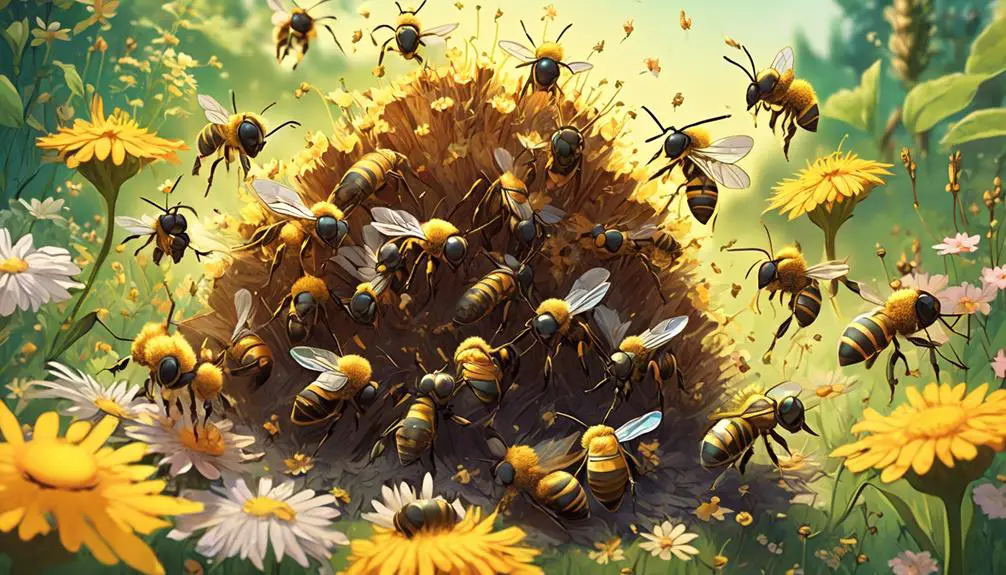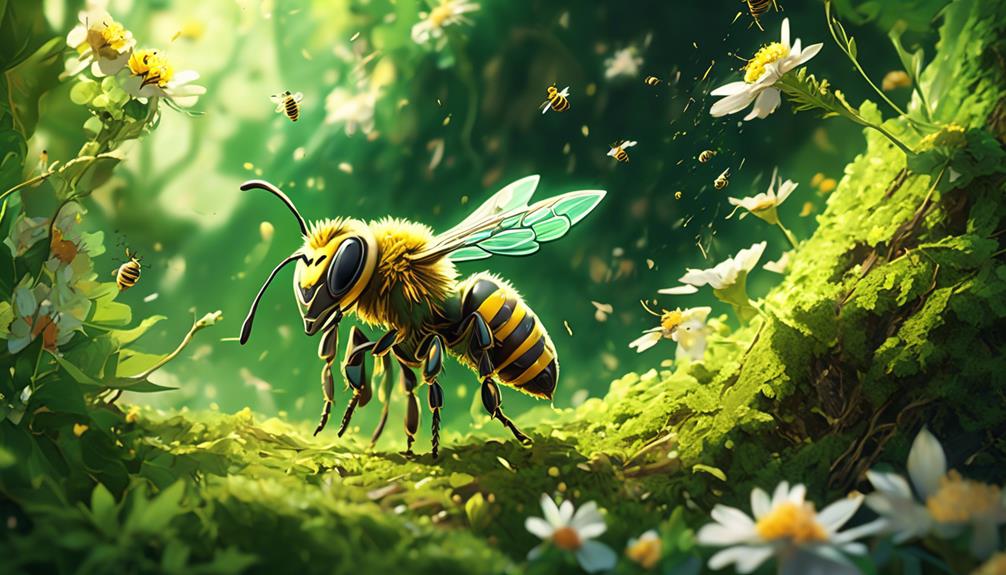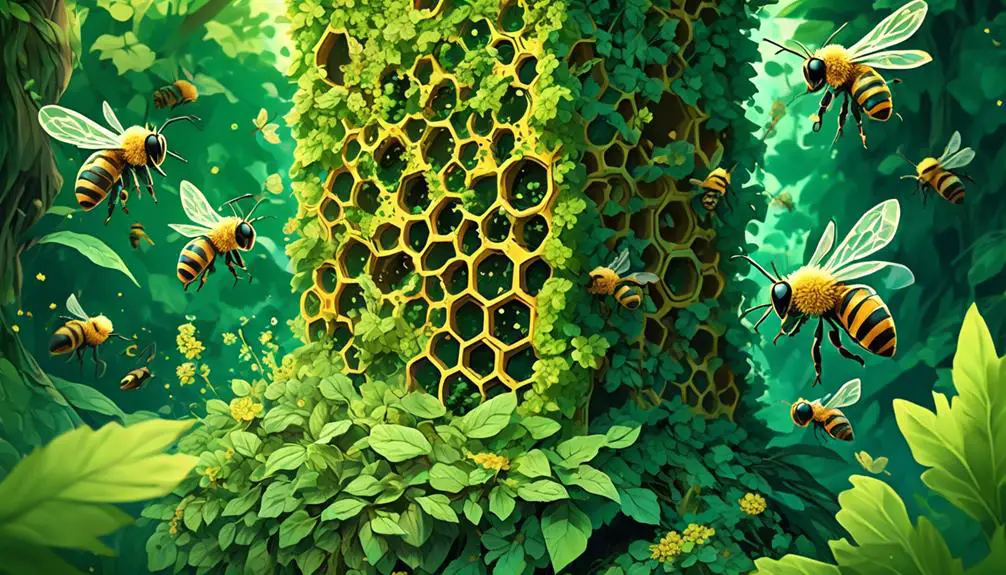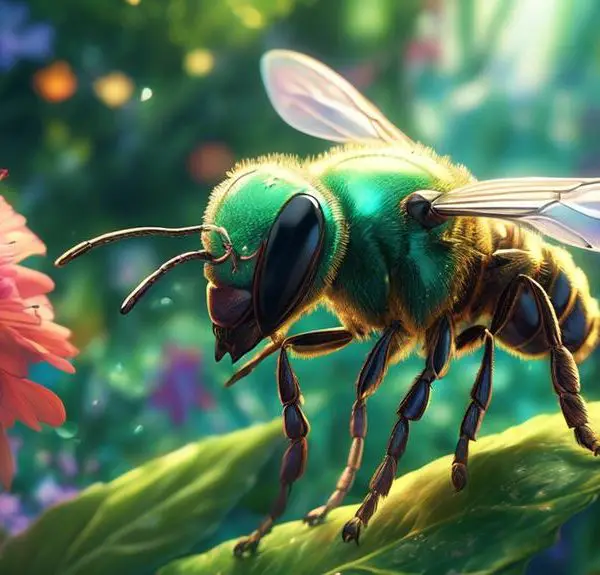Peek into the fascinating world of sweat bees and discover their unique living arrangements, more complex than you ever imagined.

Do Sweat Bees Live in Hives
Have you ever wondered whether sweat bees live in hives like their honey-producing relatives? You're not alone. Many people are intrigued by the lifestyle of these tiny, often overlooked bees.
They're called 'sweat bees' due to their peculiar attraction to human perspiration, but their living arrangements remain a mystery to many.
As we unpack this intriguing topic, you might find that the world of sweat bees is far more complex and fascinating than you'd initially imagined.
Key Takeaways
- Sweat bees primarily nest in the ground and do not form hive-like structures.
- Sweat bees can be solitary or social, with different nesting habits and behaviors.
- Sweat bees are attracted to human sweat for sodium consumption.
- Conservation efforts are important to protect sweat bee populations and their habitats.
Understanding Sweat Bees: An Overview

You might be surprised to learn that sweat bees, scientifically known as Halictidae, are a large family of bees renowned for their peculiar attraction to human sweat, which they consume for its salt content. These bees aren't just motivated by a strange desire; they're on a mission for survival. The sodium acquired from your sweat is crucial for their reproductive processes and overall health.
Despite their name, sweat bees aren't always identifiable by their sweat-seeking behavior. You'll find they're more diverse in color and size than you'd expect, with some species even glistening metallically. These bees typically measure between 3 to 10 millimeters, making them much smaller than honeybees.
Sweat bees can be solitary or social, depending on the species. Solitary species prefer to live alone, each female constructing and provisioning her own nest. On the other hand, social species form small colonies, where they share upbringing responsibilities.
Don't fret, though. While their preference for human sweat might make you cringe, they're generally harmless. Unless provoked, sweat bees are unlikely to sting. And if they do, it's much less painful than a typical bee sting. So, even though they're attracted to your perspiration, they're not something you need to sweat about.
Natural Habitats of Sweat Bees

Despite their affinity for human sweat, sweat bees can be found in a variety of natural habitats, ranging from forests and meadows to urban gardens and farms. Each habitat offers a unique set of resources and conditions that these bees utilize for survival.
In lush forests and blooming meadows, sweat bees thrive due to the abundance of nectar and pollen, their primary food sources. The diverse plant life offers a variety of flowers for the bees to forage, supporting a balanced diet. They burrow into the soft ground and create solitary nests, demonstrating their adaptability.
Urban gardens and farms, on the other hand, provide a different environment. Here, sweat bees are drawn to the human activity, as the sweat they produce contains salt, a much-needed nutrient. However, they also benefit from the diversity of cultivated plants that offer a reliable, season-long source of food.
Despite their presence in these contrasting habitats, sweat bees are sensitive to changes in their environment. Habitat destruction or alteration can significantly impact their populations. Therefore, understanding their habitat preferences is crucial to their conservation.
You've got a key role in preserving these vital pollinators.
Hive-like Structures: A Possibility?

While understanding their habitats is essential, it's equally intriguing to explore the feasibility of sweat bees constructing hive-like structures. You might wonder if these solitary creatures could adapt to a more communal living situation, akin to their honeybee cousins. However, the reality of their behavior and biology may surprise you.
Sweat bees are primarily solitary creatures. They prefer to nest in the ground, with each female bee constructing and inhabiting her individual burrow. This isn't to say that they're strictly loners. Certain species do form aggregations where numerous bees nest in close proximity, but each bee maintains her separate dwelling.
Could these aggregations evolve into a more hive-like structure? Based on current scientific understanding, it's unlikely. Sweat bees' solitary nature is deeply ingrained in their behavior and genetic programming. They lack the social structure and complex communication systems that allow honeybees to function effectively in a hive.
While it's captivating to imagine a world where sweat bees form bustling hives, this scenario appears to be more of a fascinating speculation than a probable reality. Understanding these bees' solitary tendencies is crucial to preserving their natural habitats and ensuring their survival.
Solitary Vs. Social: Sweat Bee Behavior

Although sweat bees exhibit solitary behaviors, nuances in their interactions hint at an intriguing blend of social and independent tendencies. These bees aren't confined to a binary classification of 'solitary' or 'social'. Instead, they navigate a spectrum, often exhibiting varying behaviors depending on environmental factors and specific life cycle stages.
To better understand this, let's break down their behaviour into three broad categories:
Solitary | Communal | Social | |
|---|---|---|---|
Definition | A single female bee responsible for all aspects of the life cycle. | Multiple female bees share a nest but each operates independently. | Cooperative behavior among group members. |
Nesting | Individual nests | Shared nest, individual cells | Shared nest and cells |
Food Collection | Single-handed effort | Individual effort | Collective effort |
Offspring Care | Lone responsibility | Individual responsibility | Shared responsibility |
Unfolding the Sweat Bee Mystery

In your quest to unravel the enigma of sweat bees, it's crucial to delve into their unique biological traits, behavioral patterns, and environmental influences.
Unlike honey bees, sweat bees don't live in large colonies. They're predominantly solitary creatures, although some species exhibit semi-social characteristics.
Let's take a closer look at their biology. Sweat bees are petite, usually less than half an inch long. They're named for their peculiar attraction to human sweat, from which they extract salt. This trait may seem odd, but it's a testament to their adaptability.
Their behavioral patterns are unique as well. Solitary sweat bees dig individual nests in the ground, while semi-social species share a common nest. You won't find significant hierarchies or division of labor in these nests, as is common in larger hives.
Environmental influences play a pivotal role in sweat bee behavior. They thrive in a variety of conditions, from forests to deserts, displaying remarkable resilience.
Understanding these facets helps shed light on the mystery of sweat bees. They're a testament to the diverse, adaptive strategies that bees have evolved, underscoring the complexity of the natural world.
Conclusion
In conclusion, you've discovered sweat bees are a unique species. While some do live in hive-like structures, many are solitary creatures, preferring individual burrows. This behavior differs significantly from the social nature of honey bees.
Thus, the mystery of sweat bees continues to unfold, offering us a fascinating glimpse into the diverse lifestyles of the bee world. It's crucial to continue exploring these differences to better understand and protect these important pollinators.


